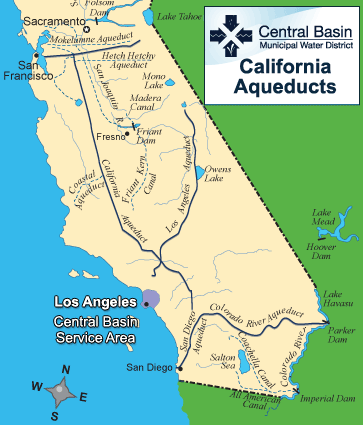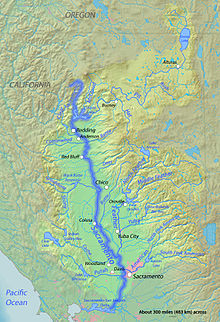California Aqueduct, in full Governor Edmund G. Brown California Aqueduct, California Aqueduct Ian Kluft principal water-conveyance structure of the California State ...
California Aqueduct
From Wikipedia, the free encyclopedia
The
Governor Edmund G. Brown California Aqueduct is a system of canals, tunnels, and pipelines that conveys water collected from the
Sierra Nevada Mountains and valleys of
Northern and
Central California to
Southern California.
[2] The over 400-mile (640 km) aqueduct is the principal feature of the
California State Water Project.
The
Department of Water Resources (DWR) operates and maintains the California Aqueduct, including one
pumped-storage hydroelectric plant,
Gianelli Power Plant. Gianelli is located at the base of
San Luis Dam, which forms
San Luis Reservoir, the largest offstream
reservoir in the United States.
The Castaic Power Plant, while similar and which is owned and
operated by the Los Angeles Department of Water and Power, is located on
the northern end of
Castaic Lake, while
Castaic Dam is located at the southern end.
Geological context
The Central Valley of California is surrounded by high mountains that
are eroding into the valley itself. The valley is somewhat rebounding
from recent ice age interglacial glaciations. The region is prone to
significant earthquakes due to the many faults and fault lines that pass
through the region.
The flatness of the valley bottom contrasts with the rugged hills or
gentle mountains that are typical of most of California's terrain. The
valley is thought to have originated below sea level as an offshore area
depressed by
subduction of the
Farallon Plate into a trench further offshore. The
San Joaquin Fault is a notable seismic feature of the Central Valley.
An example of the extreme differences between the geology of the valley
floor and that of the rugged hills of the Coast Ranges (Between Tracy
and Patterson, CA:Interstate 5)
The valley was later enclosed by the uplift of the
Coast Ranges, with its original outlet into
Monterey Bay. Faulting moved the Coast Ranges, and a new outlet developed near what is now
San Francisco Bay.
Over the millennia, the valley was filled by the sediments of these same ranges, as well as the rising
Sierra Nevada
to the east; that filling eventually created an extraordinary flatness
just barely above sea level; before California's massive flood control
and aqueduct system was built, the annual snow melt turned much of the
valley into an inland sea.
The aqueduct system
The aqueduct begins at the
San Joaquin-Sacramento River Delta at the
Banks Pumping Plant, which pumps from the
Clifton Court Forebay. Water is pumped by the Banks Pumping Plant to the
Bethany Reservoir. The reservoir serves as a forebay for the
South Bay Aqueduct via the
South Bay Pumping Plant. From the Bethany Reservoir, the aqueduct flows by gravity approximately 60 mi (97 km) to the
O'Neill Forebay at the
San Luis Reservoir. From the O'Neill Forebay, it flows approximately 16 mi (26 km) to the
Dos Amigos Pumping Plant. After Dos Amigos, the aqueduct flows about 95 mi (153 km) to where the
Coastal Branch splits from the "main line". The split is approximately 16 mi (26 km) south-southeast of
Kettleman City.
After the coastal branch, the line continues by gravity another 66 mi
(106 km) to the Buena Vista Pumping Plant. From the Buena Vista, it
flows approximately 27 mi (43 km) to the Teerink Pumping Plant. After
Teerink it flows about 2.5 mi (4.0 km) to the Chrisman Pumping Plant.
Chrisman is the last pumping plant before
Edmonston Pumping Plant, which is 13 mi (21 km) from Chrisman. South of the plant the west branch splits off in a southwesterly direction to serve the
Los Angeles Basin. At Edmonston Pumping Plant it is pumped 1,926 ft (587 m) over the
Tehachapi Mountains.
[3]
Water flows through the aqueduct in a series of abrupt rises and
gradual falls. The water flows down a long segment, built at a slight
grade, and arrives at a pumping station powered by
Path 66 or
Path 15.
The pumping station raises the water, where it again gradually flows
downhill to the next station. However, where there are substantial
drops, the water's
potential energy is recaptured by
hydroelectric
plants. The initial pumping station fed by the Sacramento River Delta
raises the water 240 ft (73 m), while a series of pumps culminating at
the Edmonston Pumping Plant raises the water 1,926 ft (587 m) over the
Tehachapi Mountains. The Edmonston Pumping station requires so much
power that several
power lines off of Path 15 and
Path 26 are needed to ensure proper operation of the pumps.
A typical section has a
concrete-lined
channel 40 feet (12 m) at the base and an average water depth of about
30 ft (9.1 m). The widest section of the aqueduct is 110 feet (34 m) and
the deepest is 32 feet (9.8 m). Channel capacity is 13,100 cubic feet
per second (370 m
3/s) and the largest pumping plant capacity at Dos Amigos is 15,450 cubic feet per second (437 m
3/s).
Branches
From its beginning until its first branch, the aqueduct passes
through parts of Contra Costa, Alameda, San Joaquin, Stanislaus, Merced,
Fresno, and Kings counties. The aqueduct then divides into three
branches: the
Coastal Branch in the Central Valley, and the
East and
West Branches after passing over the
Tehachapi Mountains.
Coastal Branch
The Coastal Branch splits from the main line 11.3 mi (18.2 km) south-southeast of
Kettleman City transiting
Kings County,
Kern County,
San Luis Obispo County, and
Santa Barbara County to deliver water to the coastal cities of
San Luis Obispo,
Santa Maria, and
Santa Barbara.
[4]
Coastal Branch is 116 mi (187 km) and five pump stations. Phase I, an
above ground aqueduct totals 15 mi (24 km) from where it branches from
the California Aqueduct, was completed in 1968. With construction
beginning in 1994, Phase II consists of 101 mi (163 km) of a 42–57-inch
(1.07–1.45 m) diameter buried pipeline extending from the Devils Den
Pump Plant, and terminates at Tank 5 on
Vandenberg Air Force Base in
Santa Barbara County. The
Central Coast Water Authority
(CCWA) extension, completed in 1997, is a (30–39 in) (76–99 cm)
diameter pipeline that travels 42 mi (68 km) from Vandenberg through
Vandenberg Village,
Lompoc,
Buellton, and
Solvang where it terminates at
Lake Cachuma in
Los Padres National Forest.
[5]
East Branch
The aqueduct splits off into the East Branch and West Branch in
extreme southern Kern County, north of the Los Angeles County line. The
East Branch supplies
Lake Palmdale and terminates at
Lake Perris, in the area of the
San Gorgonio Pass. It passes through parts of Kern, Los Angeles, San Bernardino, and Riverside counties.
West Branch
The West Branch continues to head towards its terminus at
Pyramid Lake and
Castaic Lake in the
Angeles National Forest to supply the western Los Angeles basin. It passes through parts of Kern and Los Angeles counties.
Bikeway
When it was open, the
California Aqueduct Bikeway was the longest of the paved paths in the
Los Angeles area, at 107 miles (172 km) long from
Quail Lake near Gorman through the desert to
Silverwood Lake in the
San Bernardino Mountains.
This path was closed in 1988 due to bicyclist safety and liability
issues. It is expected to remain closed indefinitely due to the
continued liability issues and an increased focus on security,
especially after the
September 11, 2001 attacks.
Pumping stations
- Phase I, Canal
- Phase II, Pipeline and Tunnel
Hydrography
Sacramento River watershed
San Joaquin River watershed and Tulare Basin
Two major river systems drain and define the two parts of the Central
Valley. Their impact on the California Aqueduct is both direct and
indirect. The
Sacramento River, along with its tributaries the
Feather River and
American River, flows southwards through the Sacramento Valley for about 447 miles (719 km).
[6] In the San Joaquin Valley, the
San Joaquin River flows roughly northwest for 365 miles (587 km), picking up tributaries such as the
Merced River,
Tuolumne River,
Stanislaus River and
Mokelumne River.
[7]
In the south part of the San Joaquin Valley, the
alluvial fan of the
Kings River
and another one from Coast Ranges streams have created a divide and
resultantly the currently dry Tulare basin of the Central Valley, into
which flow four major Sierra Nevada rivers, the Kings,
Kaweah,
Tule and
Kern. This basin, usually
endorheic, formerly filled during heavy snowmelt and spilled out into the San Joaquin River. Called
Tulare Lake, it is usually dry nowadays because the rivers feeding it have been diverted for agricultural purposes.
[8]
The rivers of the Central Valley converge in the
Sacramento-San Joaquin Delta,
a complex network of marshy channels, distributaries and sloughs that
wind around islands mainly used for agriculture. Here the freshwater of
the rivers merges with tidewater, and eventually reach the
Pacific Ocean after passing through
Suisun Bay,
San Pablo Bay, upper
San Francisco Bay and finally the
Golden Gate.
Many of the islands now lie below sea level because of intensive
agriculture, and have a high risk of flooding, which would cause salt
water to rush back into the delta, especially when there is too little
fresh water flowing in from the Valley.
[9]
The Sacramento River carries far more water than the San Joaquin, with an estimated 22 million acre feet (27 km
3) of virgin annual runoff, as compared to the San Joaquin's approximately 6 million acre feet (7.4 km
3).
Intensive agricultural and municipal water consumption has reduced the
present rate of outflow to about 17 million acre feet (21 km
3) for the Sacramento and 3 million acre feet (3.7 km
3)
for the San Joaquin; however, these figures still vary widely from year
to year. Over 25 million people, living both in the valley and in other
regions of the state, rely on the water carried by these rivers.
[10]
In popular culture
A documentary about the decline of the United States' infrastructure,
The Crumbling of America,
[11] was commissioned by the U.S.
A&E network in the late 2000s. The documentary is typically shown on the
History television channel in the United States, although other educational broadcasters globally have shown it. It features the
Clifton Court Forebay
(a primary intake point for California Aqueduct) as a "strategic piece
of California freshwater infrastructure" subject to shutdown for up to
two years if struck by an earthquake of magnitude 7.5 or greater.
See also
References

 The Delta–Mendota Canal (left) and the California Aqueduct (right) near Tracy, California
The Delta–Mendota Canal (left) and the California Aqueduct (right) near Tracy, California




No comments:
Post a Comment